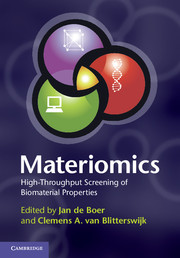Book contents
- Frontmatter
- Contents
- List of contributors
- Preface
- Chapter 1 Introducing materiomics
- Chapter 2 Physico-chemical material properties and analysis techniques relevant in high-throughput biomaterials research
- Chapter 3 Materiomics using synthetic materials: metals, cements, covalent polymers and supramolecular systems
- Chapter 4 Microfabrication techniques in materiomics
- Chapter 5 Bioassay development
- Chapter 6 High-content imaging
- Chapter 7 Computational analysis of high-throughput material screens
- Chapter 8 Upscaling of high-throughput material platforms in two and three dimensions
- Chapter 9 Development of materials for regenerative medicine: from clinical need to clinical application
- Chapter 10 Non-biomedical applications of materiomics
- Chapter 11 Beyond bed and bench
- Index
- References
Chapter 4 - Microfabrication techniques in materiomics
Published online by Cambridge University Press: 05 April 2013
- Frontmatter
- Contents
- List of contributors
- Preface
- Chapter 1 Introducing materiomics
- Chapter 2 Physico-chemical material properties and analysis techniques relevant in high-throughput biomaterials research
- Chapter 3 Materiomics using synthetic materials: metals, cements, covalent polymers and supramolecular systems
- Chapter 4 Microfabrication techniques in materiomics
- Chapter 5 Bioassay development
- Chapter 6 High-content imaging
- Chapter 7 Computational analysis of high-throughput material screens
- Chapter 8 Upscaling of high-throughput material platforms in two and three dimensions
- Chapter 9 Development of materials for regenerative medicine: from clinical need to clinical application
- Chapter 10 Non-biomedical applications of materiomics
- Chapter 11 Beyond bed and bench
- Index
- References
Summary
Scope
This chapter deals with an overview of basic microfabrication techniques. The goal is to explain to the reader how such techniques can be utilized in the field of materiomics. The basic processes used in microfabrication including photolithography, etching, electron beam lithography and micromoulding are explained. Some classic examples of these techniques as applied to materiomics are also shown. Furthermore, possible uses of such techniques, and the development and application of hybrid techniques to be able to answer fundamental questions about biological behaviour of materials, are also suggested.
Basic principles of microfabrication
Introduction
Techniques used to fabricate structures or devices smaller than 100 µm are commonly referred to as microfabrication techniques. Initially meant for the electronics industry, they have found a wide range of applications in diverse fields such as chemical engineering and the life sciences. Since the early 1990s, the application of microfabrication technologies in the area of chemical and biological analysis has been termed ‘micro total analysis systems’ (µTAS) (1). Microfabricated devices meant for µTAS initially offered the advantage of sample analysis on the microscale, but over the years, the evolution of these technologies has led to the facilitation of sample preparation, fluid handling, separation systems, cell handling and cell culturing in an integrated manner (1). The application of microtechnologies for the fabrication of devices or systems to study material properties benefits from cost efficiency, high performance, precision-based design flexibility, miniaturization and automated analysis. Miniaturization involves the convergence of multiple disciplines, such as fluid dynamics, material sciences, engineering and the life sciences, that need to join expertise in order to design functional systems. Moreover, these devices can be used to evaluate biological behaviour in vitro and can help us to test thousands of different biomaterials and surface properties without the complexity related to in vivo assays.
- Type
- Chapter
- Information
- MateriomicsHigh-Throughput Screening of Biomaterial Properties, pp. 51 - 66Publisher: Cambridge University PressPrint publication year: 2013



